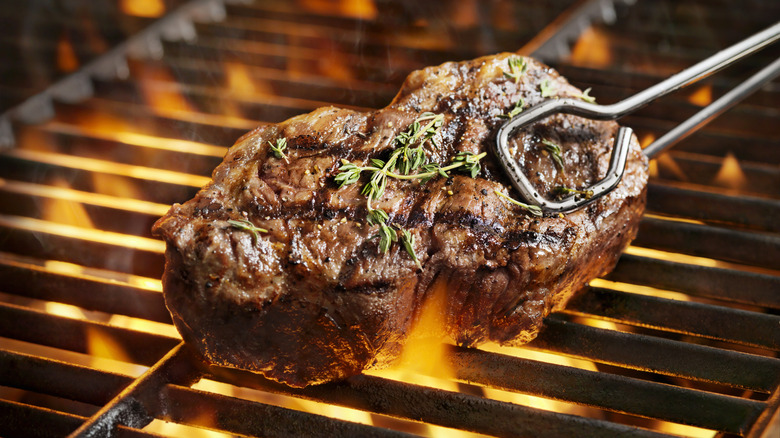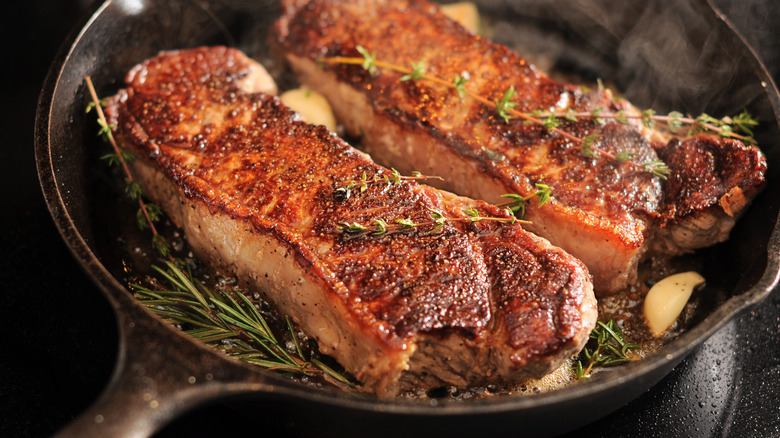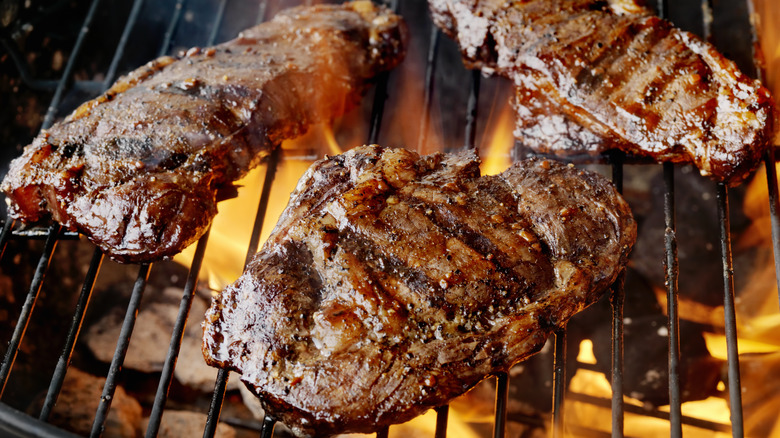The Side Of Steak You Cook First Actually Matters
Preparing a steak at home can be one of the most rewarding experiences. Choose a foolproof method for cooking, and your effort will be rewarded with a luxurious meal. No matter what technique you use, however, you still need to focus on the small things — in this case, it's choosing the side of steak to start heating up. There are many reasons why you should always sear the fattier side first.
For starters, it gives you a head start on rendering out fat. As the steak cooks, its fats will melt out, with the meat bathing in the moisture and taking on extra flavor. Because of this, you'll want the to cook this side as long as possible, so that it can render properly.
Fatty meat will also brown quicker than lean meat, because fat and heat trigger the Maillard reaction (the process where meat browns and becomes delicious). Letting a steak's more marbled side cook longer will give you more of that browned flavor. As the fat cooks, it also begins to crisp up and form a crust — and the only way to get that crust is through time and heat. Starting on this side of the steak gives you more time to achieve this process without overcooking it.
Why fat is important when it comes to flavor
Ever heard somebody say that fat is where the flavor is? This statement is essentially true. Although it doesn't have much flavor on its own, fat makes food taste better (think of how oil and butter turn dishes richer). When it comes to steak, the flavor compounds in meat tend to bind to sticky fat, and these are what get released when we eat. This is why high-fat cuts like wagyu beef are prized by chefs as their intense marbling gives them an unrivaled flavor.
Fat can also create pleasant textural contrasts, a big reason why the crust on your steak makes the whole thing more enjoyable to eat. Think of the texture of crispy bacon or crunchy pork rinds, as other examples. These are all products of cooking fat until it renders and crisps up. Similarly, basting a butter-fried steak adds even more fat to the equation, and creates a delicious golden crust.
It's important, however, to get that fat nice and crispy; this means you should watch your steak closely, and make sure you're not left with any unappetizing bits.
Getting the most out of your steak
If you're cooking a steak with a large fat cap, you can score the fatty area before cooking. To do this, place some shallow vertical cuts into the fat. This will not only help it brown faster, but it will allow the fat to render out more quickly. Because of this, go for a steak that is at least 1½-inches thick. A thinner option will cook too quickly, meaning it can become overdone before everything has properly browned.
Because you're using a thick piece of meat, you also need to salt it heavily so that the seasoning can penetrate through the surface; salting will also help draw out its moisture. This is important because moisture is the enemy of browning. Excess liquid means that the meat can't cook any hotter than water's boiling point of 212 degrees Fahrenheit, and the Maillard reaction doesn't start to occur until 300 degrees Fahrenheit.
This is the same reason you should thoroughly dry a steak before cooking. This ensures the browning process starts as soon as the meat hits the pan, rather than waiting until the moisture has evaporated. For even better results, try salting your steak and letting it rest in the refrigerator overnight. This technique, known as dry brining, will thoroughly remove moisture, giving you an ultra-dry surface and intensely seasoned meat.



